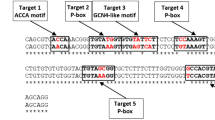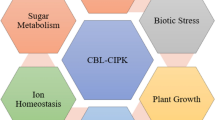Abstract
Genetically engineered tobacco (Nicotiana tabacum L.) with the ability to accumulate glycinebetaine was established. The wild type and transgenic plants were exposed to heat treatment (25–50°C) for 4 h in the dark and under growth light intensity (300 μmol m−2 s−1). The analyses of oxygen-evolving activity and chlorophyll fluorescence demonstrated that photosystem II (PSII) in transgenic plants showed higher thermotolerance than in wild type plants in particular when heat stress was performed in the light, suggesting that the accumulation of glycinebetaine leads to increased tolerance to heat-enhanced photoinhibition. This increased tolerance was associated with an improvement on thermostability of the oxygen-evolving complex and the reaction center of PSII. The enhanced tolerance was caused by acceleration of the repair of PSII from heat-enhanced photoinhibition. Under heat stress, there was a significant accumulation of H2O2, O −2 and catalytic Fe in wild type plants but this accumulation was much less in transgenic plants. Heat stress significantly decreased the activities of catalase, ascorbate peroxidase, glutathione reductase, dehydroascorbate reductase, and monodehydroascorbate reductase in wild type plants whereas the activities of these enzymes either decreased much less or maintained or even increased in transgenic plants. In addition, heat stress increased the activity of superoxide dismutase in wild type plants but this increase was much greater in transgenic plants. Furthermore, transgenic plants also showed higher content of ascorbate and reduced glutathione than that of wild type plants under heat stress. The results suggest that the increased thermotolerance induced by accumulation of glycinebetaine in vivo was associated with the enhancement of the repair of PSII from heat-enhanced photo inhibition, which might be due to less accumulation of reactive oxygen species in transgenic plants.










Similar content being viewed by others
Abbreviations
- APX:
-
Ascorbate peroxidase
- CAT:
-
Catalase
- DHAR:
-
Dehydroascorbate reductase
- F o, F m :
-
Minimal and maximal fluorescence in dark-adapted state
- F o′, F m′:
-
Minimal and maximal fluorescence in light-adapted state
- F s :
-
Steady-state chlorophyll fluorescence level in light-adapted state
- F v/F m :
-
Maximal efficiency of PSII photochemistry
- F v′/F m′:
-
Efficiency of excitation capture by open PSII centers
- ΦPSII :
-
Actual PSII efficiency
- GB:
-
Glycinebetaine
- GR:
-
Glutathione reductase
- MDHAR:
-
Monodehydroascorbate reductase
- OEC:
-
Oxygen-evolving complex of photosystem II
- PSII:
-
Photosystem II
- q P :
-
Photochemical quenching coefficient
- RC:
-
Reaction center of photosystem II
- SOD:
-
Superoxide dismutase
- ROS:
-
Reactive oxygen species
References
Aebi H (1984) Catalase in vitro. Meth Enzymol 105:121–126
Alia, Hayashi H, Sakamoto A, Murata N (1998) Enhancement of the tolerance of Arabidopsis to high temperatures by genetic engineering of the synthesis of glycinebetaine. Plant J 16:155–161
Alia, Sakamoto A, Nonaka H, Hayashi H, Saradhi PP, Chen THH, Murata N (1999) Enhanced tolerance to light stress of transgenic Arabidopsis plants that express the codA gene for a bacterial choline oxidase. Plant Mol Biol 40:279–288
Allakhverdiev SI, Feyziev YM, Ahmed A, Hayashi H, Alie JA, Klimov VV, Murata N, Carpentier R (1996) Stabilization of oxygen evolution and primary electron transport reactions in photosystem II against heat stress with glycinebetaine and sucrose. Photochem Photobiol 34:149–157
Allard F, Houde M, Kröl M, Ivanov A, Huner NPA, Sarhan F (1998) Betaine improves freezing tolerance in wheat. Plant Cell Physiol 39:1194–1202
Arakawa N, Tsutsumi K, Sanceda NG, Kurata T, Inagaki C (1981) A rapid and sensitive method for the determination of ascorbic acid using 4,7-diphenyl-1,10-phenanthroline. Agri Biol Chem 45:1289–1290
Arakawa K, Katayama M, Takabe T (1990) Levels of betaine in green leaves and etiolated leaves and roots of barley. Plant Cell Physiol 31:797–803
Arakawa T, Timasheff SN (1985) The stabilization of proteins by osmolytes. Biophys J 47:411–414
Arrigoni O, Dipierro S, Borraccino G (1981) Ascorbate free radical reductase: a key enzyme of the ascorbic acid system. FEBS Lett 125:242–244
Asada K (1999) The water-water cycle in chloroplasts: scavenging of active oxygen and dissipation of excess photons. Annu Rev Plant Physiol Plant Mol Biol 50:601–639
Bowler C, Montagu MV, Inze D (1992) Superoxide dismutase and stress tolerance. Annu Rev Plant Physiol Plant Mol Biol 43:83–116
Bradford MM (1976) A rapid and sensitive method for the quantification of microgram quantities of protein using the principal of protein–dye binding. Anal Biochem 72:248–254
Brennan T, Frenkel C (1977) Involvement of hydrogen peroxide in the regulation of senescence in pear. Plant Physiol 59:411–416
Deshnium P, Gombos Z, Nishiyama Y, Murata N (1997) The action in vivo of glycine in enhancement of tolerance of Synechococcus sp. strain PCC 7492 to low temperature. J Bacteriology 179:339–344
Elstner FF, Heupel C (1976) Inhibition of nitrite formation from hydroxylammoniumchloride: a simple assay for superoxide dismutase. Anal Biochem 70:616–620
Evans PJ, Halliwell B (1994) Measurements of iron and copper in biological systems: bleomycine and copper–phenanthroline assays. Meth Enzymol 233:82–92
Genty B, Briantais JM, Baker NR (1989) The relationship between the quantum yield of photosynthetic electron transport and quenching of chlorophyll fluorescence. Biochim Biophys Acta 99:87–92
Giannopolitis GN, Reis SK (1977) Superoxide dismutase I. Occurrence in higher plants. Plant Physiol 59:309–315
Gorham J (1995) Betaines in higher plants—biosynthesis and role in stress metabolism. In: Wallsgrove RM (ed) Amino acids and their derivatives in higher plants. Cambridge University Press, Cambridge, pp 171–203
Griffiths OW (1980) Determination of glutathione and glutathione disulphide using glutathione reductase and 2-vinylpyridine. Anal Biochem 106:207–212
Hayashi H, Alia, Mustardy L, Deshnium P, Ida M, Murata N (1997) Transformation of Arabidopsis thaliana with the coda gene for choline oxidase: accumulation of glycinebetaine and enhanced tolerance to salt and cold stress. Plant J 12:133–142
Holmström KO, Somersalo S, Mandal A, Palva ET, Welin B (2000) Improved tolerance to salinity and low temperature in transgenic tobacco producing glycine betaine. J Exp Bot 51:177–185
Hossain MA, Asada K (1984) Purification of dehydroascorbate reductase from spinach and its characterization as a thiol enzyme. Plant Cell Physiol 25:85–92
Ishitani M, Arakawa K, Mizuno S, Kishitani S, Takabe T (1993) Betaine aldehyde dehydrogenase in the Gramineae-levels in leaves of both betaine-accumulating and non-accumulating cereal plants. Plant Cell Physiol 34:493–495
Izawa S (1980) Acceptors and donors for chloroplast electron transport. Methods Enzymol 69:413–433
Jiang M, Zhang J (2001) Effect of abscisic acid on active oxygen species, antioxidative defence system and oxidative damage in leaves of maize seedlings. Plant Cell Physiol 42:1265–1273
Ladyman JAR, Hitz WD, Hanson AD (1980) Translocation and metabolism of glicine betaine by barley plants in relation to water stress. Planta 150:191–196
Matoh T, Watanabe J, Takahashi E (1987) Sodium, potassium, chloride, and betaine concentrations in isolated vacules from salt-grown Atriplex gmelini leaves. Plant Physiol 84:174–177
McNeil SD, Nuccio ML, Hanson AD (1999) Betaines and related osmoprotectants: targets for metabolic engineering of stress resistance. Plant Physiol 120:945–949
Melis A, Homann PH (1975) Kinetics analysis of the fluorescence induction in 3-(3,4-dichlorophenyl)-1,1-dimethylurea poisoned chloroplasts. Photochem Photobiol 21:431–437
Murata N, Mohanty PS, Hayashi H, Papageorgiou GC (1992) Glycinebetaine stabilizes the association of extrinsic proteins with the photosynthetic oxygen-evolving complex. FEBS Lett 296:187–189
Nakano Y, Asada K (1981) Hydrogen peroxide is scavenged by ascorbate peroxidase in spinach chloroplasts. Plant Cell Physiol 22:867–880
Nash D, Miyao M, Murata N (1985) Heat inactivation of oxygen evolution in photosystem II particles and its acceleration by chloride depletion and exogenous manganese. Biochim Biophys Acta 807:127–133
Nishiyama Y, Allakhverdiev SI, Murata N (2005) Inhibition of the repair of photosystem II by oxidative stress in cyanobacteria. Photosynth Res 84:1–7
Noctor G, Foyer CH (1998) Ascorbate and glutathione: keeping active oxygen under control. Annu Rev Plant Physiol Plant Mol Biol 49:249–279
Nomura M, Hibino T, Takabe T, Sugyama T, Yokota A, Miyake H, Takabe T (1998) Transgenically produced glycinebetaine protects ribulose 1,5-bisphosphate carboxylase/oxygenase from inactivation in Synechococcus sp. PCC7942 under salt stress. Plant Cell Physiol 39:425–432
Ohnishi N, Murata N (2006) Glycinebetaine counteracts the inhibitory effects of salt stress on the degradation and synthesis of the D1 protein during photo inhibition in Synechococcus. Plant Physiol (DOI:10.1104/pp.106.076976)
Papageorgiou GC, Murata N (1995) The unusually strong stabilizing effects of glycine betaine on the structure and function of the oxygen-evolving photosystem II complex. Photosynth Res 44:243–252
Park EJ, Jeknic Z, Sakamoto A, DeNomal J, Yuwansiri R, Murata N, Chen THH (2004) Genetic engineering of glycinebetaine synthesis in tomato protects seeds, plants, and flowers from chilling damage. Plant J 40:474–487
Porra RJ, Thompson WA, Kriedemann PE (1989) Determination of accurate extinction coefficients and simultaneous equations for assaying chlorophyll a and b extracted with four different solvents: verification of the concentration of chlorophyll standards by atomic absorption spectroscopy. Biochim Biophys Acta 975:384–394
Rhodes D, Hanson AD (1993) Quaternary ammonium and tertiary sulfonium compounds in higher plants. Annu Rev Plant Physiol Plant Mol Biol 44:357–384
Rhodes D, Rich PJ, Brunk DG, Rhodes JC, Pauly MH, Hansen LA (1989) Development of two isogenic sweet corn hybrids differing for glycinebetaine content. Plant Physiol 91:1112–1121
Sakamoto A, Murata N (2001) The use of bacterial choline oxidase, a glycinebetaine-synthesizing enzyme, to create stress-resistant transgenic plants. Plant Physiol 125:180–188
Sakamoto A, Murata N (2002) The role of glycine betaine in the protection of plants from stress: clues from transgenic plants. Plant Cell Environ 25:163–171
Sakamoto A, Valverde R, Alia, Chen THH, Murata N (2000) Transformation of Arabidopsis with the coda gene for choline oxidase enhances freezing tolerance of plants. Plant J 22:449–453
Sakamoto A, Alia, Murata N (1998) Metabolic engineering of rice leading to biosynthesis of glycinebetaine and tolerance to salt and cold. Plant Mol Biol 38:1011–1019
Schaedle M, Bassham JA (1977) Chloroplast glutathione reductase. Plant Physiol 59:1011–1012
Schobert B (1977) Is there an osmotic regulatory mechanism in algae and higher plants? J Theor Biol 68:17–26
Srivastava A, Guissé B, Greppin H, Strasser RJ (1997) Regulation of antenna structural and electron transport in photosystem II of Pisum sativum under elevated temperature probed by the fast polyphasic chlorophyll a fluorescence transient: OKJIP. Biochim Biophys Acta 1320:95–106
Strasser BJ (1997) Donor side capacity of photosystem II probed by chlorophyll a fluorescence transients. Photosynth Res 52:147–155
Strasser RJ, Srivastava A, Govindjee (1995) Polyphasic chlorophyll a fluorescence transients in plants and cyanobacteria. Photochem Photobiol 61:32–42
Yang X, Liang Z, Lu C (2005) Genetic engineering of the biosynthesis of glycinebetaine enhances photosynthesis against high temperature stress in transgenic tobacco plants. Plant Physiol 138:2299–2309
Yamane Y, Kashino Y, Koike H, Satoh K (1998) Effects of high temperatures on the photosynthetic systems in spinach: oxygen-evolving activities, fluorescence characteristics and the denaturation process. Photosynth Res 57:51–59
Acknowledgments
This work was supported by the Frontier Project of the Knowledge Innovation Engineering of the Chinese Academy of Sciences (grant no. KSCXZ-SW-326) and by the Program of 100 Distinguished Young Scientists of Chinese Academy of Sciences to Congming Lu as well as by Innovation Foundation of Shandong Agricultural University for Young Scientists.
Author information
Authors and Affiliations
Corresponding author
Rights and permissions
About this article
Cite this article
Yang, X., Wen, X., Gong, H. et al. Genetic engineering of the biosynthesis of glycinebetaine enhances thermotolerance of photosystem II in tobacco plants. Planta 225, 719–733 (2007). https://doi.org/10.1007/s00425-006-0380-3
Received:
Accepted:
Published:
Issue Date:
DOI: https://doi.org/10.1007/s00425-006-0380-3




